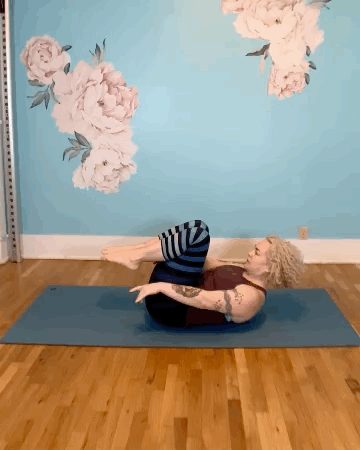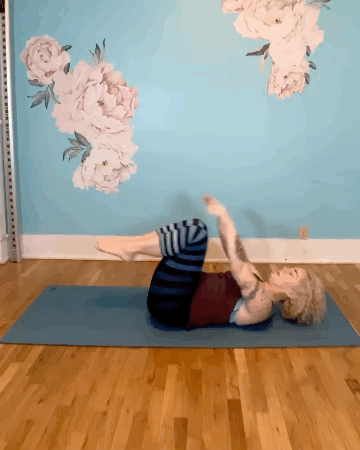Hollow body is ubiquitous in circus: chances are good that it was one of the first things you learned in your very first class, and you probably hear it all the time: hollow body! Tuck your pelvis!
Yet, whenever I’m training new instructors I always ask them what the definition of hollow body is and why it’s important, and no one can answer my question!
So let’s start by breaking down what hollow body means, and then talk about when it’s useful and (more importantly) when it’s NOT.
Hollow body is a shape that allows us to fix all of our joints in a static position.
When we do that, our bodies can become one, relatively stiff, unit- as opposed to a bunch of parts hanging off a trunk, which is what our bodies normally are.
This stiff unit is going to help you when your body is moving dynamically, doing something like a flip or a wheeldown. You’ll have a lot more control if you’re one stiff thing moving through space, rather than something floppy with extra parts hanging off of it. Likewise, if you’re trying to hold your body in a line the way you would in a front or back lever, you need that stiffness to keep your body from collapsing.
Hollow body is also changing our alignment, taking away the natural curvature of the spine that we’re supposed to have when we’re walking around on our feet. This is important for a couple of reasons.
When we tuck and flatten our low backs, it’s recruiting all of our abdominals and connecting our ribs and pelvis so they act as a single unit instead of two separate structures. When we’re walking around in neutral, the pelvis and ribs twist in opposition to each other as our arms and legs swing in opposition. The tuck is limiting our ability to twist and helping us fix our low backs in place.
A hollow shape is also changing the position of the pelvis relative to the ribs. This allows us to balance the pelvis over the ribs when we’re inverted, either hanging or on our hands. When we’re walking around on our feet, our pelvis is a super stable structure that our ribs balance over. When we’re upside down, we need our ribs and shoulder girdle to become that stable structure so we can balance the pelvis on top. That’s what hollow body allows you to do!
When you’re in hollow body, you should be using basically all of your muscles. It’s a really active position! Your arms are fixed either overhead or by your sides with straight elbows, you’re pulling your ribs and pelvis together using all your abs, your hips are in extension so your butt should be working really hard, your legs are squeezing together and your knees are straight, and (hopefully) your toes are pointed. That’s a lot of work!

But so often, this skill gets introduced by teaching students to tuck and flatten their backs without addressing the rest of the parts, or including drills to refine and strengthen the position.

Hollow body is NOT just a tucked pelvis! And this, friends, is where we start running into problems.
This over emphasis on tucking the pelvis can create a whole host of other issues including rectus dominance (I wrote a whole other post about that), and that can keep you from building strength in a balanced way or creating efficient pathways during movements like leg lifting or inverting.
Instead we need to be strengthening our bodies to be stable in a variety of positions, most importantly in neutral.
Neutral, or neutral spine, is exactly what it sounds like. It should be the default position of your body when you’re walking around and doing regular daily activity. We’ll define it as the position where your spine has it’s natural curvature and your hip bones and your pubic bone are on the same plain. Neutral provides the most support for your spine, especially if you’re adding heavy load to your body like you do when you lift things.
Neutral spine is like a blank slate for movement. You’re starting fresh, nothing is working harder than it should be and therefore when you do move you can put all your available power into it. From neutral, you can hollow or arch, twist and rotate, pike, side bend, or whatever you need to do, and make that movement more efficient and powerful. It gives you more options for movement, and when we have options we can do more, bigger, and more interesting things!
And who doesn’t want that??
So, how do you learn more about training a neutral spine?
Pilates is a great place to start, neutral spine is a foundation of the methodology.
Or you could find a good strength and conditioning coach to work with, as a neutral spine is really important when you’re working with heavy loads.
Want to know how to put this all together at home? Check out my online course The Regular Person’s Guide to Aerial Conditioning at Home!
In this 6 week course, you’ll learn all about how to use your neutral spine, and how to strengthen and develop your hollow body. You’ll also get workouts to improve mobility and active flexibility + strengthen your body in aerial specific pathways AND promote full body balance for day to day life.
You’ll also get my support for the whole 6 weeks. You can ask me questions, share videos for feedback, and benefit from my years of experience helping regular people like you learn how to practice aerial in a way that supports their bodies in a way that is both safe and challenging.
Early bird pricing ends on October 16th, sign up now to save $50!
Click here to learn more and sign up.

Hi Lauren,
That was so well said! I appreciate how you differentiated between movement goals for upright locomotion vs stability for high level athletic tasks. Bravo!
Thank you!!
This is an interesting topic. Hollow spine is so useful for so many acrobatic movements, particularly anything with excessive non-upright force. For aerial and for handstands the hollow spine of the chest and shoulders also helps connect the lats and shoulder muscles to the abdominals in motion, or for holding for extended time or with additional force. It also helps us invert by rolling through the spine and shortening the lever, rather than arching and extending the lever. Its all about efficiency of movement. However, you are completely right that we need to make more effort to work in neutral, arched or rotated spinal positions as well. This gives us much more mobility and expressivity in our movement and is healthier for our bodies. When training at the professional or semi-professional level its really easy to over use the hollow spine and create those muscle imbalance problems and injuries you talk about on your ‘circus is pain’ page. Almost every acrobat or aerialist I know including myself has a closed shoulder position from exactly this, which does create problems. We all need to be doing ballet or something similar that uses a lot of open positions, as a counter-work! As a teacher I have also found this to have gotten worse with amateurs as well as so many people now spend so long at the computer which has a similar effect on the posture.